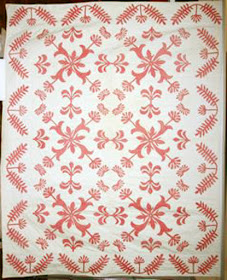A couple of years ago Cindy Brick posted a picture
of this antique quilt asking for a name.
Are those leaves or a cornucopia rotating around the
central point?
It looks vaguely familiar I says to myself.
(Actually they all look vaguely familiar at this point.)
Then I found this one pictured in
Safford & Bishop's 1987 book
America's Quilts and Coverlets
"228. c. 1850, 100" x 74". The applique designs
are done entirely in dark blue and set in a
handsome overall pattern of almost classic regularity. (Cora Ginsburg)"
The caption indicates that New York antique textile dealer Cora Ginsburg was the source for the photo.
Until I looked closely I thought they were the same quilt but they are not. Another pair of twins separated at birth.
A pattern name?
A regional source?
And then I found a third in the Quilt Index.
Collection:
Beaver County Historical Research & Landmarks Foundation
Freedom, Pennsylvania.
Documented by the Western Pennsylvania Quilt Documentation Project
Triplets.
Same block, same border design.
It is one unusual pattern, not only in the parts
but how it is set together.
How is it set together?
Note red lines---is it an appliqued block with an
appliqued sash?
The red one is easier to figure out. My squares are out of whack
but it looks like appliqued squares and appliqued sashing with an empty cornerstone.
UPDATE: Karan F thought the basic block might be larger than I saw it.
She's likely correct. This would be easier.
There are not many relatives---even distant relations.
Here's a remarkably early quilt from the
DAR Museum and the Quilt Index.
Deborah Wilson.
Inscribed "D. W. 1783"
Made in Baltimore.
Kind of a cornucopia....
Mid 19th century, online auction
Another mid-19th century
with a rotating or whirling cornucopia.
This has that cornucopia shape rotating more symmetrically around the center;
looks 20th century.
The imagery has deep roots in textile design.
Above is a detail from a circa 1640 Italian knitted garment.
It's pictured in Cora Ginsberg's 2014 catalog.
Page through it here.
And right before posting time I found this version in the Virginia Beauchamp watercolor file at the Onondaga NY Library. She painted local patterns about 1920. No name though.


















Wow, thanks for all the research you do! Not only do I find inspiration from you, but knowledge! And, I love history!
ReplyDeleteThese are fascinating examples. In Cindy Brick's post the motif in question reminds me of a flower with a protruding stamen, such as a hibiscus. Some of the following quilts also have a floral feel but perhaps the original appliqué or pattern was not derived from nature but from other needlework such as the knit example or from crewel work which had been inspired by eastern textiles. The original form undergoes change, simplification, distortion through time. An example is the pomegranate, now almost unidentifiable in modern interpretations. Thank you for presenting these quilts together.
ReplyDeleteThank you, Barbara! I really appreciate your pursuing this. (Gee, I think I could have thought of the title "Original Folk Art Applique," though...)
ReplyDelete